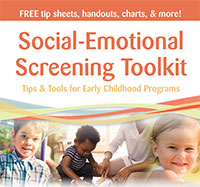13 Tips for Sharing Social-Emotional Screening Results with Families
January 7, 2025
Is your early childhood program using ASQ®:SE-2 for social-emotional screening yet? A recent final rule from the Administration for Children and Families (ACF) emphasized the importance of screening for social and emotional development and following up with parents, and ASQ:SE-2 is the tool your program needs to do both effectively. (See why in this blog post!)
It’s important to always share ASQ:SE-2 results with families. They’ll be interested in learning about their child’s social-emotional development, and they’ll be important partners in helping their children make progress. Use these practical tips to prepare carefully for your discussions with families after social-emotional screening—especially when you’ll be sharing results that indicate a child needs further assessment.
Be timely. Provide screening follow-up information as quickly as you can.
Restate the purpose of screening. Remind parents that screening is a check of their child’s social-emotional development. ASQ:SE-2 only shows that their child may need further assessment; it does not diagnose their child.
Show you value confidentiality. Be sure the setting for your conversation is private and assure parents that what you share is confidential.
Use the ASQ:SE-2 Parent Conference Sheet. This sheet will help you organize your thoughts and take notes during the conversation or parent conference. (The sheet is included in the ASQ:SE-2 Starter Kit and the Social-Emotional Screening Toolkit.)
Listen to the family. Give parents an opportunity to express their perceptions of their child. Be open to new ideas and viewpoints.
Highlight strengths. Review the ASQ:SE-2 results, emphasizing the child’s social-emotional strengths. (Hint: All items with a score of 0 points are strengths for the child.) Also, be sure to focus on a family’s current skills and resources.
Explain the child’s results. Be precise—use language such as well above the cutoff, close to the cutoff, and below the cutoff when explaining the child’s scores.
Be sensitive and positive. Avoid using terms like fail, normal, or abnormal.
Examine concerns together. Discuss any concerns, and provide specific, objective examples of children’s social-emotional development whenever possible.
Discuss anything that may have affected the child’s scores. This could include the child’s health history or specific cultural or environmental factors.
Offer guidance. Provide information about social-emotional development. If a child’s score is above the cutoff or if the parent has concerns, provide information about community resources and referral options.
Talk about next steps in social-emotional development. If the child’s social-emotional development is on track, talk with parents about what skills and behaviors to expect next.
Provide learning activities that families can try at home. Give families fun, developmentally appropriate activities they can do with their children to promote social-emotional development. Let them know they’ll have an opportunity to discuss their child’s development again in the future. (Rescreen in 6–12 months if possible.)





Write a Comment
Your email address will not be published. Required fields are marked *
Post a Comment